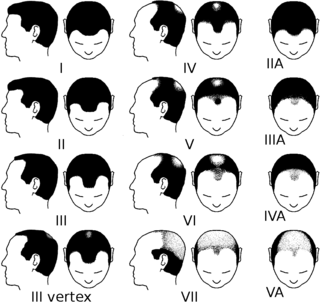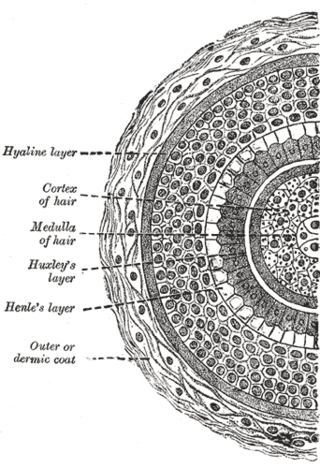Dermatology is the branch of medicine dealing with the skin. It is a speciality with both medical and surgical aspects. A dermatologist is a specialist medical doctor who manages diseases related to skin, hair, nails, and some cosmetic problems.

Goose bumps, goosebumps or goose-pimples are the bumps on a person's skin at the base of body hairs which may involuntarily develop when a person is tickled, cold or experiencing strong emotions such as fear, euphoria or sexual arousal.

Vellus hair is short, thin, light-colored, and barely noticeable hair that develops on most of a human’s body during childhood. Exceptions include the lips, the back of the ear, the palm of the hand, the sole of the foot, some external genital areas, the navel, and scar tissue. The density of hair – the number of hair follicles per area of skin – varies from person to person. Each strand of vellus hair is usually less than 2 mm long and the follicle is not connected to a sebaceous gland.

The Hamilton–Norwood scale is used to classify the stages of male pattern baldness. The stages are described with a number from 1 to 7.
Trichology is the study of the hair and scalp. The term derives from Ancient Greek θρίξ (thríx), "hair" and -λογία -logia. In most jurisdictions the title of a trichologist, not the field of trichology, is considered a para-medical discipline.

Trichobacteriosis axillaris is a superficial bacterial colonization of the hair shafts in sweat gland–bearing areas, such as the armpits and the groin. It is a trivial disease of worldwide occurrence that is believed to be caused by the genus Corynebacteria.

White piedra is a mycosis of the hair caused by several species of fungi in the genus Trichosporon. It is characterized by soft nodules composed of yeast cells and arthroconidia that encompass hair shafts.

The inner or epidermic coat of the hair follicle is closely adherent to the root of the hair, and consists of two strata named respectively the outer and inner root sheaths.
The inner root sheath or internal root sheath of the hair follicle is located between the outer root sheath and the hair shaft. It is made of three layers: Henle's layer, Huxley's layer, and the cuticle.
Madarosis is a condition that results in the loss of eyelashes, and sometimes eyebrows. The term "madarosis" is derived from the ancient Greek "madaros", meaning "bald". It originally was a disease of only losing eyelashes but it currently is the loss of both eyelashes and eyebrows. Eyebrows and eyelashes are both important in the prevention of bacteria and other foreign objects from entering the eye. A majority of patients with madarosis have leprosy, and it was reported that 76% of patients with varying types of leprosy had madarosis.

Microsporum audouinii is an anthropophilic fungus in the genus Microsporum. It is a type of dermatophyte that colonizes keratinized tissues causing infection. The fungus is characterized by its spindle-shaped macroconidia, clavate microconidia as well as its pitted or spiny external walls.
Trichostasis spinulosa is a common but rarely diagnosed disorder of the hair follicles that clinically gives the impression of blackheads, but the follicles are filled with funnel-shaped, horny plugs that are bundles of vellus hairs.
Antonella Tosti is an Italian physician and scientist with major contributions in the field of dermatology, including developing dermoscopy for the diagnosis and care of hair diseases. Her contributions to knowledge about nails include research about videodermoscopy of the hyponychium and the nail plate.
Canities subita, also called Marie Antoinette syndrome or Thomas More syndrome, is an alleged condition of hair turning white overnight due to stress or trauma. The trivial names come from specific cases in history including that of Queen Marie Antoinette of France whose hair was noted as having turned stark white overnight after her capture following the ill-fated flight to Varennes during the French Revolution. An older case of Sir Thomas More's hair turning white the night before his beheading has also been recorded. Although a number of cases of rapid hair greying have been documented, the underlying patho-physiological changes have not been sufficiently studied.

Trichomegaly is a condition in which the eyelashes are abnormally long, objectively defined as 12mm or greater in the central area and 8mm in the peripheral. The term was first used by H. Gray in 1944 in a publication in the Stanford Medical Bulletin, though he was only the third person to characterize the disorder; the first two reports were published in German in 1926 and 1931 by Reiter and Bab, respectively. Gray suggested the use of the term "movie lashes" to describe this condition, for long lashes were at the time being portrayed in film as a desirable characteristic in women.

Collagen induction therapy (CIT), also known as microneedling, dermarolling, or skin needling, is a cosmetic procedure that involves repeatedly puncturing the skin with tiny, sterile needles. CIT should be separated from other contexts in which microneedling devices are used on the skin.
In the field of dermatology, the Renbök phenomenon is a phenomenon where one skin condition inhibits another. It is also known as the reverse Koebner phenomenon. The term was first used by Happle et al. in 1991. The word "Renbök" is a neologism, made from a reversal of the letters of the name "Köbner".
Premature greying of hair (PGH), also known as canities, can have negative effects on appearance, self-confidence, self-esteem, and social acceptance of the affected individual. Hair is said to have greyed prematurely if it occurs before the age of 20 years in Europeans, before 25 years in Asians, and before 30 years in Africans.
Frictional alopecia is the loss of hair that is caused by rubbing of the hair, follicles, or skin around the follicle. The most typical example of this is the loss of ankle hair among people who wear socks constantly for years. The hair may not grow back even years after the source of friction has ended.

Hair oil is an oil-based cosmetic product intended to improve the condition of hair. Various types of oils may be included in hair oil products. These often purport to aid with hair growth, dryness, or damage.









